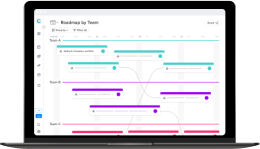Build Smarter, More Impactful Technology Roadmaps

FAQ
How often should a technology roadmap be updated?
A technology roadmap should evolve with your business. Review it regularly, at least once a quarter, to reflect new priorities, resources, or market changes. For example, you might update it after a product launch or new customer feedback. With Craft.io’s Timeline View, every change is instantly visible to your team.
What are the key elements of a strong technology roadmap?
While every organization is different, the most effective technology roadmaps share a few essential components that drive clarity, accountability, and progress:
- Strategic goals or OKRs connected to initiatives
- Milestones and dependencies across teams
- Infrastructure and architectural improvements alongside product plans
- KPIs to measure progress and impact
- Tools (like Craft.io) to visualize and share updates dynamically
Can small teams or startups benefit from technology roadmapping?
Absolutely. A technology roadmap helps small teams stay focused and make smart technical decisions that support long-term growth. It keeps everyone aligned on priorities and shows investors or new hires how the team plans to scale with purpose.
What’s the biggest mistake teams make when building a technology roadmap?
Many teams treat the roadmap as a static document instead of a living plan. When it isn’t updated regularly, it quickly loses value. Using an interactive tool like Craft.io keeps your roadmap connected to real progress, so priorities, timelines, and outcomes stay accurate and actionable.

